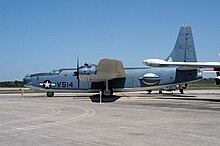
The Lockheed EP-3 is an electronic signals reconnaissance variant of the P-3 Orion, primarily operated by the United States Navy.

The Douglas A-3 Skywarrior is a jet-powered strategic bomber that was developed and produced by the Douglas Aircraft Company. It was designed by Douglas on behalf of the United States Navy, which sought a carrier-capable strategic bomber. During July 1949, Douglas was awarded the contract to produce its design, having bested eight other aircraft companies' submissions. Unlike rival designs, which had aimed for a 100,000 lb (45,000 kg) maximum take-off weight, the Skywarrior was developed for a 68,000 lb (31,000 kg) take-off weight, facilitating its use from the navy's existing Midway-class aircraft carriers. Large portions of the aircraft were produced by the Westinghouse Electric Corporation, including its early Westinghouse J40 turbojet engines, which failed to meet promises and were replaced by the rival Pratt & Whitney J57 engine by mid-1953. On 28 October 1952, the prototype XA3D-1 performed the type's maiden flight.

The Martin P4M Mercator was a maritime reconnaissance aircraft built by the Glenn L. Martin Company. The Mercator was an unsuccessful contender for a United States Navy requirement for a long-range maritime patrol bomber, with the Lockheed P2V Neptune chosen instead. It saw a limited life as a long-range electronic reconnaissance aircraft. Its most unusual feature was that it was powered by a combination of piston engines and turbojets, the latter being in the rear of the engine nacelles.

Naval Air Station Sanford was a naval air station of the United States Navy in Sanford, Florida, approximately 20 miles north of Orlando, Florida. Opening less than a year after the start of World War II, NAS Sanford's initial function was as an advanced training base for land-based patrol bombers, followed by carrier-based fighter aircraft. The air station briefly closed in 1946 and was placed in caretaker status until being reactivated in 1950. It eventually served as a Master Jet Base for carrier-based heavy attack and reconnaissance aircraft until 1969. After its closure, it reopened as civilian general aviation airport under various names with a non-Navy civilian airport identifier until finally transitioning to a scheduled air carrier airport under its current name of Orlando-Sanford International Airport.

VP-23, Patrol Squadron 23, known as the Seahawks, was a U.S. Navy fixed-wing, anti-submarine and maritime patrol squadron based at Brunswick Naval Air Station, Brunswick, Maine, United States. It was established as Weather Reconnaissance Squadron Three (VPW-3) on 17 May 1946, redesignated as Meteorology Squadron Three (VPM-3) on 15 November 1946, redesignated Heavy Patrol Squadron (Landplane) Three (VP-HL-3) on 8 December 1947, and to Patrol Squadron Twenty Three (VP-23) on 1 September 1948 and disestablished on 28 February 1995. It was the second squadron to be designated VP-23, the first VP-23 was redesignated Patrol Bombing Squadron 23 (VPB-23) on 1 October 1944 and disestablished on 25 January 1946.
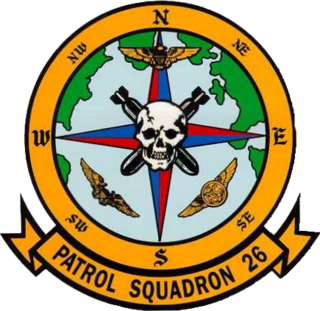
The VP-26 Tridents are a United States Navy aircraft squadron based at Naval Air Station Jacksonville in Florida. The squadron flies Boeing P-8A patrol aircraft. It was established as Bombing Squadron 114 (VB-114) on 26 August 1943 and renamed Patrol Bombing Squadron 114 (VPB-114) on 1 October 1944; Patrol Squadron 114 (VP-114) on 15 May 1946; Heavy Patrol Squadron (Landplane) 6 (VP-HL-6) on 15 November 1946, and Patrol Squadron 26 (VP-26) on 1 September 1948. The Tridents are the third squadron to be designated VP-26; the first VP-26 was renamed VP-102 on 16 December 1940, and the second VP-26 was renamed VP-14 on 1 July 1941.

Electromagnetic Attack Squadron 131 (VAQ-131), also known as the "Lancers," is a United States Navy tactical jet aircraft squadron specializing in kinetic and non-kinetic Suppression of Enemy Air Defenses (SEAD). They are based at Naval Air Station Whidbey Island, flying the EA-18G Growler. Their radio callsign is "Skybolt."

VAQ-33, nicknamed the Firebirds, was a Tactical Electronic Warfare Squadron of the U.S. Navy, serving for 44 years (1949–1993) under various designations and with a constantly-evolving group of aircraft. It was designated VAQ-33 in 1968, at which time it operated the piston-powered EA-1F Skyraider, or Spad. The squadron had the distinctions of being the last Navy unit to operate the A-3 Skyraider, and of making its last carrier deployment, in 1969. The retirement of the Spad marked the beginning of the squadron's decades-long role as a pioneering electronic aggressor squadron. That role ended with electronic aggressor missions being transferred to the Navy Reserve and the squadron's disestablishment at NAS Key West on 1 October 1993.
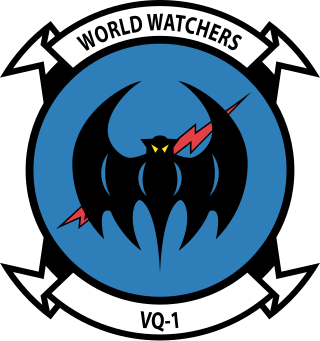
Fleet Air Reconnaissance Squadron 1 (VQ-1) is an aviation unit of the United States Navy established on 1 June 1955. Its role is aerial reconnaissance and signals intelligence. The squadron is nicknamed the "World Watchers" and is based at NAS Whidbey Island, flying Lockheed EP-3E Aries II aircraft.

Patrol Squadron 30 (VP-30) is a maritime patrol squadron of the United States Navy, established on 30 June 1960. It is based at Naval Air Station Jacksonville, Florida.

VAP-62 was a Heavy Photographic Squadron of the U.S. Navy. Originally established as Photographic Squadron Sixty-Two (VJ-62) on 10 April 1952, it was redesignated as Heavy Photographic Squadron (VAP-62) on 2 July 1956. The squadron was disestablished on 15 October 1969.

RVAH-1 was a Reconnaissance Attack (Heavy) Squadron of the U.S. Navy. Originally established as Heavy Attack Squadron One (VAH-1) on 1 November 1955, it was redesignated as Reconnaissance Attack (Heavy) Squadron One (RVAH-1) on 1 September 1964. The squadron was disestablished on 29 January 1979.
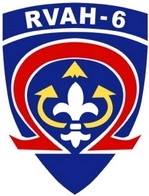
RVAH-6 was a Reconnaissance Attack (Heavy) Squadron of the U.S. Navy. Originally established as Composite Squadron Six (VC-6) on 6 January 1950, it was redesignated as Heavy Attack Squadron Six (VAH-6) on 1 July 1956 and was redesignated as Reconnaissance Attack (Heavy) Squadron Six (RVAH-6) on 23 September 1965. The squadron was disestablished on 20 October 1978.

RVAH-9 was a Reconnaissance Attack (Heavy) Squadron of the U.S. Navy. Originally established as Composite Squadron Nine (VC-9) on 15 January 1953, it was redesignated as Heavy Attack Squadron Nine (VAH-9) on 1 November 1955 and was redesignated as Reconnaissance Attack (Heavy) Squadron Nine (RVAH-9) on 3 June 1964. The squadron was disestablished on 30 September 1977.
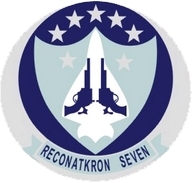
RVAH-7 was a reconnaissance attack (heavy) squadron of the U.S. Navy. Originally established as Composite Squadron Seven (VC-7) on 10 August 1950, it was redesignated as Heavy Attack Squadron Seven (VAH-7) on 1 November 1955 and was redesignated again as Reconnaissance Attack (Heavy) Squadron Seven (RVAH-7) on 1 December 1964. The squadron was disestablished on 28 September 1979.

RVAH-5 was a Reconnaissance Attack (Heavy) Squadron of the U.S. Navy. Originally established as Composite Squadron Five (VC-5) at Naval Air Station Moffett Field, California on 9 September 1948, it was redesignated as Heavy Attack Squadron Five (VAH-5) on 1 November 1955 and was later redesignated as Reconnaissance Attack (Heavy) Squadron Five (RVAH-5) in May 1964. The squadron was disestablished on 30 September 1977.
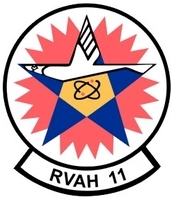
RVAH-11 was a Reconnaissance Attack (Heavy) Squadron of the U.S. Navy. Originally established as Composite Squadron Eight (VC-8) on 3 December 1951, it was redesignated Heavy Attack Squadron Eleven (VAH-11) on 1 November 1955 and was redesignated as Reconnaissance Attack (Heavy) Squadron Eleven (RVAH-11) on 1 July 1966. The squadron was disestablished on 1 June 1975.

RVAH-3 was a Reconnaissance Attack (Heavy) Squadron of the U.S. Navy that served as the Fleet Replacement Squadron (FRS) for the RVAH community. Originally established as Heavy Attack Squadron Three (VAH-3) on 15 June 1956, it was redesignated as Reconnaissance Attack (Heavy) Squadron Three (RVAH-3) on 1 July 1964. The squadron was disestablished on 17 August 1979.

VP-21 was a Patrol Squadron of the U.S. Navy. The squadron was established as Established as Bombing Squadron 111 (VB-111) on 30 July 1943, redesignated Patrol Bombing Squadron 111 (VPB-111) on 1 October 1944, redesignated Patrol Squadron 111 (VP-111) on 15 May 1946, redesignated Heavy Patrol Squadron (Landplane) 11 (VP-HL-11) on 15 November 1946, redesignated Patrol Squadron 21 (VP-21) on 1 September 1948 and disestablished on 21 November 1969. It was the fifth squadron to be designated VP-21, the first VP-21 was redesignated VP-45 on 1 July 1939, the second VP-21 was redesignated VP-1 on 30 July 1940, the third VP-21 was disestablished on 18 April 1942 and the fourth VP-21 was redesignated VPB-21 on 1 October 1944.

Fleet Air Reconnaissance Squadron 6 (VQ-6) was a former squadron of the U.S. Navy's Atlantic Fleet. During its short-lived career, it was the second of two squadrons to operate the ES-3A Shadow, an ELINT version of the Lockheed S-3 Viking.

